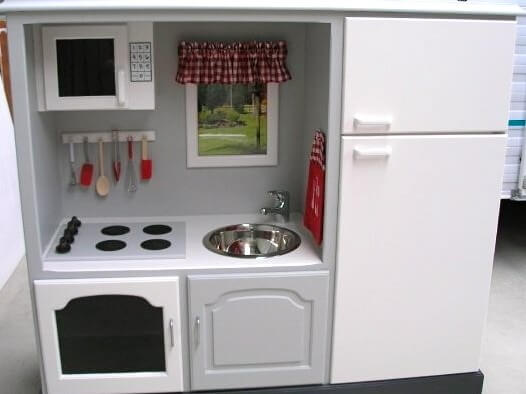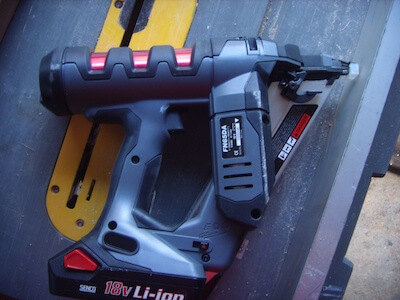Last week I discovered a blog site called “Tool Snob”, dedicated to reviewing, as it’s name aptly conveys, tools, as well as tool-related events and websites. I am a budding DIYer and am always looking for new gadgets to help me accomplish my projects in a faster and easier fashion. Today’s syndicated blog reviews a power tool any DIYer would dig hanging up on their peg board.
Posted July 20, 2010 by Tool Snob
Senco Fusion F-15 Cordless Finish Nailer – Review
There’s been a lot of buzz around the Senco Fusion. And if you’re to believe what Senco has been saying about it, there should be. To give it all some context, you need to know that, to date, the technology behind cordless finish guns seems, well, incomplete. There are the gas powered guns, which take a battery and a removable gas cartridge, but they smell terrible and have the added expense of replacing the gas cartridge. Then there are the nailers powered by a flywheel motor, which have solved the dual fuel problem (as well as the odor), but are lacking in power, particularly when dealing with hardwoods. So there are options out there, but you’re getting yourself into a trade off; sure I don’t have a compressor or hoses, but I’ve got a smelly gas cartridge or I’ve got a gun that has some difficulty with mahogany. There isn’t any ideal situation out there.
So the Senco Fusion seeks to fill this gap and combine the best of both arenas. Its goal is to fuse the maneuverability of the cordless gun with the power of the traditional pneumatic nailer. And how does it attempt to do this, you ask?
 Well, it’s interesting and very smart actually. The fuel source for the Fusion is a built-in tank filled with nitrogen gas (the red thing in the picture). The tank is pressurized at the factory to a set level with the pressurized gas sitting behind the firing piston. When the trigger is pulled, the motor, powered by a rechargeable li-ion battery, releases a stop on the firing piston, which then blasts out a nail. Then the motor resets the piston back into the go position, once again pressurizing the tank, and locks it in place ready for the next nail.
Well, it’s interesting and very smart actually. The fuel source for the Fusion is a built-in tank filled with nitrogen gas (the red thing in the picture). The tank is pressurized at the factory to a set level with the pressurized gas sitting behind the firing piston. When the trigger is pulled, the motor, powered by a rechargeable li-ion battery, releases a stop on the firing piston, which then blasts out a nail. Then the motor resets the piston back into the go position, once again pressurizing the tank, and locks it in place ready for the next nail.
What’s so great about this is that it’s an entirely closed system. The gas stays in the tank throughout the whole process, meaning that the amount of pressure (a.k.a. nailing power) in the tank doesn’t change over time (Actually Senco admits that there is eventually going to be some loss, but that’s after 100,000 nails and it’s a relatively minimal loss). There’s also no smelly out-gassing.
Senco was nice enough to put a Fusion in our hands about a month and a half ago and since then we’ve done quite a lot with it. We ran some trim, we installed some ballisters, we stood in the shop and unloaded a few magazines of nails just for the hell of it, and we showed the gun to every carpenter we came in contact with.
 A few observations on the Fusion:
A few observations on the Fusion:
Weight – Because of the on-board tank and the firing mechanism, the Fusion is heavier than any of the air-powered guns that you’re going to buy (Fusion: 6.1 lbs, the new Paslode air nailer 3.8 lbs), and it’s generally heavier than the gas-powered nailers, but lighter than the fly-wheelers. Everyone we showed it to mentioned the heft of the tool. Some of them liked it because it felt solid, and none of them thought it was a deal breaker once they started firing off some nails.
 Battery life – While the nitrogen tank can theoretically last until dinosaurs roam the earth again, the li-ion battery needs some recharging from time to time. The battery has a built-in charge indicator which is very handy seeing as the Fusion only comes with a single battery. But if you’re smart about it, you never be dealing with dead batteries before lunch break. According to Senco, one battery can drive about 600 nails. So unless you move like The Flash, that should be plenty for a day’s work.
Battery life – While the nitrogen tank can theoretically last until dinosaurs roam the earth again, the li-ion battery needs some recharging from time to time. The battery has a built-in charge indicator which is very handy seeing as the Fusion only comes with a single battery. But if you’re smart about it, you never be dealing with dead batteries before lunch break. According to Senco, one battery can drive about 600 nails. So unless you move like The Flash, that should be plenty for a day’s work.
One thing to watch out for though is the ‘on’ switch. It’s a small little thing located at the base of the handle with three positions; sequential fire, off, and bump fire (more on this below). Obviously, the gun won’t fire in the off position, but if you store the gun with it switched to one of the firing modes, like we accidentally did a few times, the battery will slowly drain down. We would have liked some kind of ‘on’ indicator light to help prevent this but there isn’t one, so it’s just up to you and your goldfish memory.
Power – The power on this gun is as good as anything you’re going to get out of a compressor. And that alone, even without taking any of the other features into consideration, makes the Fusion a success. It put nail after nail into solid oak and then solid mahogany. It never once let us down. The gun has a very firm kick to it and the report is pretty loud, but the power is impressive. Everyone we showed it to was impressed with the power.
Depth of Drive – The Fusion has a depth of drive gauge that’s probably the nicest one we’ve seen. In addition to the standard thumb wheel, there’s a line gauge that indicates where you are in the depth, taking the guess work out of the equation. In the past, we would pick up a gun and have to dial it all the way in, just so we had a reference point to start from. Not with the Fusion. It’s not a huge feature, but it’s a really slick touch.
Removable magazine – If a nail jams (and none did while we were using it), it’s a very easy operation to remove the magazine entirely. Just pop a little thumb clip and pull it down. Like the depth gauge, it’s not an essential piece of the puzzle, but it’s a really nice one.
 Case – A very nice case rounds out the package. It’s a bit bulky, but there is plenty of room to store extra nails, safety glasses, or a six-pack of PBR.
Case – A very nice case rounds out the package. It’s a bit bulky, but there is plenty of room to store extra nails, safety glasses, or a six-pack of PBR.
Crowd reaction – Every single person who touched the Fusion wanted one. It was like jobsite heroin. Some guys just wouldn’t put it down and a few others stole it out of our truck just to get a second look at it. It’s pretty rare that we see a tool get this kind of reception, even from the crusty old-timers.
So we, like everyone else who came in contact with it, became obsessed with the Fusion in a very short period of time. Can we nit-pick it and point out a couple negative things? Oh yeah, sure. The nose difficult to deal with because there are no markings telling where the nail is going to land. To us, one of the keys to fine finish work is nail placement, and the Fusion doesn’t offer any help in this department. We got the feel for it after a while, but it seems silly not to have some kind of placement marks.
 Also, the gun, like many finish guns these days, has a toggle between sequential fire and bump fire. This trend baffles us. If you don’t know, bump fire is a mode that allows the user to hold the trigger down and bump the nose of the gun repeatedly against the workpiece, firing a nail at each bump. It’s used aggressively and universally with framing guns and goes a long way to speed up production. But on a finish gun? To us, a finish gun with bump fire is like a baby stroller with a Hemi. Speed is not what you’re looking for in a finish nailer and if someone showed up at our house to do some trim work and we saw that their finish gun was in bump fire mode, we’d show them the door pretty fast. Maybe if you’re making prefab houses in a warehouse or something, but even then, take some pride in your nail placement. Slow the hell down. Bump fire on a framer is one thing, but a finish gun? It’s insane, and the Fusion isn’t all that great at it anyway. The time it takes for the piston to reset is long enough so that we couldn’t get into a good rhythm with the bump fire. it’s not like we care though, because we’ll never use the feature.
Also, the gun, like many finish guns these days, has a toggle between sequential fire and bump fire. This trend baffles us. If you don’t know, bump fire is a mode that allows the user to hold the trigger down and bump the nose of the gun repeatedly against the workpiece, firing a nail at each bump. It’s used aggressively and universally with framing guns and goes a long way to speed up production. But on a finish gun? To us, a finish gun with bump fire is like a baby stroller with a Hemi. Speed is not what you’re looking for in a finish nailer and if someone showed up at our house to do some trim work and we saw that their finish gun was in bump fire mode, we’d show them the door pretty fast. Maybe if you’re making prefab houses in a warehouse or something, but even then, take some pride in your nail placement. Slow the hell down. Bump fire on a framer is one thing, but a finish gun? It’s insane, and the Fusion isn’t all that great at it anyway. The time it takes for the piston to reset is long enough so that we couldn’t get into a good rhythm with the bump fire. it’s not like we care though, because we’ll never use the feature.
Regardless of our little rant, we couldn’t be any more impressed with the Fusion and there is no question that it is is the new gold standard in cordless finish guns. It’s powerful, it’s maneuverable, and it’s very, very cool. The future is now.
And it isn’t cheap either. $400 for the gun, a case, and one battery. While there might be a little sticker shock around the number, we think that the gun is worth it. For a contractor, it will pay for itself in no time. For a DIYer looking for a finish gun, if you’re not spending any money on a compressor or hoses, $400 is a bargain for such a high-quality tool. There is also an 18 gauge brad nailer available as well.














